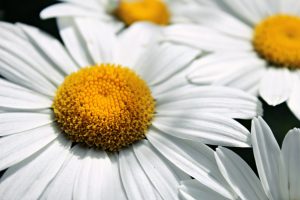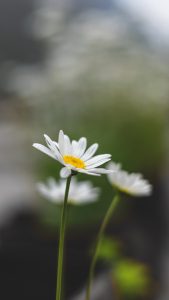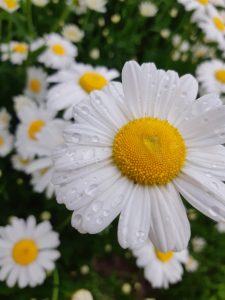
Calendula. Calendula are edible and healthy daisies.
Also known as Pot Marigold, Calendula aren’t actually marigolds. They are part of the Asteracea family, along with daisies and chrysanthemums.
Calendula have edible blooms that are loaded with antioxidant compounds. The colorful petals are high in carotenoids, such as flavoxanthin and auroxanthin.
Historically, Calendula have been used for muscle spasms, fever, pain and swelling. The organic extract has anti-viral effects, so it’s good to use when viruses are floating around.
Like now.
How To Prepare It

Pluck the petals from the green flower base, and they can be eaten raw or cooked. You can add dried flowers to soups and the fresh petals to salads.
Calendula have a sharp taste that resembles saffron, and the flavors range from spicy to bitter, and tangy to peppery. A drop of honey helps tame the taste.

Tea
One of the best ways to consume Calendula is to prepare it as a tea. Take powdered or dried Calendula and steep it in boiling water for about 10 to 20 minutes. You can drink the tea and use it as a mouthwash to treat a sore throat or wounds inside your mouth.
- Simmering water with dried flowers
Place around 1 to 2 tablespoons of dried Calendula flowers in a heat proof mug and pour around 1 cup (8 oz/240 ml) simmering hot water over them.
Cover with a saucer and steep for around 15 to 20 minutes.
- Simmering water with fresh flowers
Fill a heat-proof jar with fresh flowers and pour simmering hot water over them.
Cover and let infuse until the tea is cool enough to drink.
Tincture
Press the juice from a fresh plant. The dose for the tincture is between 25 and 75 drops (that’s a big spread) taken 1 to 4 times per day.

Wound Healing
Use Calendula cream as soon as you can on a fresh wound because it can help lessen scarring by assisting in new tissue growth. It is also effective with painful wounds that have become infected, and is good to put on wounds that keep opening up, on wounds that do not heal well, and on deep wounds.
Heating a warm compress of Calendula tea can be used for eye infections.
Calendula flower tea is commonly used to help with peptic ulcers, gastroesophageal reflux disease (GERD), and inflammatory bowel disease (IBD). It supports healing of gastric and intestinal inflammation, too.

Caution
If you have allergies, you can react to Calendula like you would react to ragweed, which is in the same family.
Calendula has been known to start the menstrual cycle, so you should not use it if pregnant or breastfeeding.
Calendula acts like a sedative, so it can cause sleepiness or drowsiness. This works great if you have trouble falling asleep, but taking Calendula along with other sedative medications might cause you to get too drowsy. So, be cautious if using clonazepam (Klonopin®), lorazepam (Ativan®), phenobarbital (Donnatal®), zolpidem (Ambien®)
_______________
If you want to learn more about disease prevention, contact me at janethull.com. Remember that you are never alone when you are looking for good health!
Gain access to all of my online programs, ongoing support, monthly Q&A, and more by joining my Private Inner Circle Membership Program. I look forward to supporting you on your journey to alternative health and wellness.
_____________
Disclaimer: This article is for informational purposes only, and is educational in nature. The FDA may not have evaluated some of the statements. This article is not intended to diagnose, treat, cure, or prevent any disease. Please discuss with your own, qualified health care provider before adding supplements or making any changes to your dietary program.
Before taking vitamins, consult your doctor; pre-existing medical conditions or medications you are taking can affect how your body responds to multivitamins.
You have our permission to reprint this article if you attribute us with a live back-link to this article and the youtube links. https://janethull.com/